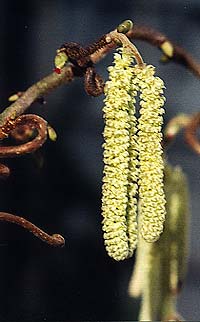 Corkscrew
Corkscrew
Hazel Catkins
"I have drunk ale from the Country of the Young
And weep because I know all things now:
I have been a hazel tree & they hung
The Pilot Star & the Crooked Plough
Among my leaves in times out of mind."
-W.B. Yeats
(1865-1939)
(1865-1939)
 Our seven foot tall corkscrew hazel (Corylus avellana 'Contorta') stands at the head of a woodland garden path where it gets moderate sunlight.
Our seven foot tall corkscrew hazel (Corylus avellana 'Contorta') stands at the head of a woodland garden path where it gets moderate sunlight.In spring & summer & early autumn, it has large crinkly leaves so dense it hides the exaggerated corkscrew appearance of the limbs. So to great extent this is a more interesting tree in winter when the branches are bare & their eerie windings most obvious.
Its autumn colors are not extraordinary, but pleasant enough. Right up to mid-November it is still fully leafed, but the green turns to yellow, as can be seen on the Contorted Hazel page of the Autumn Trees Garden Walk. By November's end the leaves have turned brown & fall to the ground. These crumpled-looking brown leaves make a most attractive winter mulch.
That it blooms in late winter adds tremendously to its extravagant cold-season interest. The September photo second to the bottom of this page shows the emerging male flowers amidst the leaves, when they are still very small & hard. These green catkins lengthen through November & December & dominate after leaf-fall, as shown in the December portrait lowermost on the page. These burst into soft, bright golden catkins in February, lasting through March.
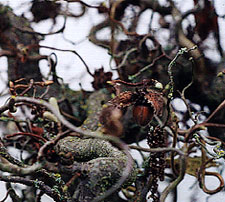 At the same time as the hard green catkins become large fluffy golden ones, there is also a purple female blossom just above the catkin. This bloom is so tiny it is easily overlooked, but once you realize it indeed has these flowers, they accompany every catkin set, & are wonderfully bright micro-blooms. The first two photos on this page, taken early March, show the teency purple bloom, the photo upper right in close-up detail.
At the same time as the hard green catkins become large fluffy golden ones, there is also a purple female blossom just above the catkin. This bloom is so tiny it is easily overlooked, but once you realize it indeed has these flowers, they accompany every catkin set, & are wonderfully bright micro-blooms. The first two photos on this page, taken early March, show the teency purple bloom, the photo upper right in close-up detail. The interaction of catkin & flower can cause that tiny flower to become a full-sized filbert by the following autumn, though the corkscrew variety frequently never does produce the edible nuts. We're lucky to have this added feature, as ours does produce a few filberts each year, as seen in photo at the right taken in winter showing a filber still attached in its burst casing. There are not enough to be worth harvesting so we leave them on the tree for their decorativeness, & some will cling until the following spring.
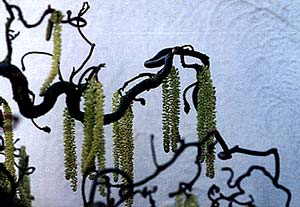 This tree is also called Contorted Filbert & Harry Lauder's Walking Stick. Sir Harry Lauder (1870-1950) was a Scot & a leading music hall entertainer who sang lovely ballads & told jokes on himself. He was greatly beloved in his day, & was knighted by King George V for service to the country in the first World War, wherein his only son was killed.
This tree is also called Contorted Filbert & Harry Lauder's Walking Stick. Sir Harry Lauder (1870-1950) was a Scot & a leading music hall entertainer who sang lovely ballads & told jokes on himself. He was greatly beloved in his day, & was knighted by King George V for service to the country in the first World War, wherein his only son was killed.American soldiers were entertained by Lauder during the war & afterward he toured America where he gained a considerable following. He was briefly a film star in the early 1930s. Yet he's not well remembered now, & the tree baring his name is increasingly just called Corkscrew Hazel, though more than an occasional home owner has been known to give their corkscrew the pet name Harry.
His signature song "Roamin' in the Gloamin'" is still well known, though many mistake it for a folk tune when in fact Sir Harry wrote it. The lasting image of the tight-fisted Scot with a twisted walking cane — originated by Lauder & imitated by many a stage & film comedian, including Danny Kaye — has outlasted Lauder's international fame, to the annoyance of some Scots who've wearied of the stereotype.
This Corylus originated as a natural "sport" in England in the mid-1800s, growing in a hedgerow with ordinary European filberts. It is often trained as a multi-limbed bush rather than as a tree with a single trunk. Ours was grown as an upright graft. The rootstock sends up suckers that are not contorted, & these have to be removed to keep the energy in the contorted branches.
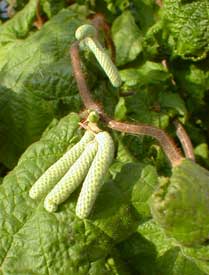 Most but not all specimens are grafted, so occasional specimens will not have uncontorted suckers to remove & will not have a straight trunk for a leader. As a small tree or large shrub, it can reach ten or occasionally fifteen feet of height, but our seven footer is one of the biggest we've seen around Puget Sound. Most we've encountered have been small shrubs.
Most but not all specimens are grafted, so occasional specimens will not have uncontorted suckers to remove & will not have a straight trunk for a leader. As a small tree or large shrub, it can reach ten or occasionally fifteen feet of height, but our seven footer is one of the biggest we've seen around Puget Sound. Most we've encountered have been small shrubs.A friend has several that form a beautiful macabre hedge up the side of a staircase, many years old but still only about four feet tall. Another friend has one that died, but he keeps it in his garden anyway, & its still attractive & has stood in the garden for several years as a trellis. We hope ours does eventually reach ten feet or more, but their rapid growth definitey slows down somewhere at the six foot margin.
A hardy cultivar with few demands, the root system is amazingly dense. When we first obtained it as a rootbound potted tree, it was an extremely large pot with heavier roots than on trees we've obtained three times the height. I remember the hell of a time I had getting it out of the pot, then it rolled into the hole by itself, I couldn't stop it because it was too heavy. Granny Artemis wasn't home that day & I'm afraid it took me about three hours to position the thing, because after it rolled into the hole which was the wrong depth, I literally had to arrange ropes & lever the lift tree upward & fill in the hole, & really shouldn't've been attempting it alone.
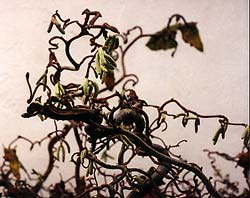 I did a lot of cussing that day to be certain. And some while later, when I heard someone claiming they were planning to dig up & transplant a contorted hazel, I had flashbacks of horror, & warned them they might be surprised how much root is down there.
I did a lot of cussing that day to be certain. And some while later, when I heard someone claiming they were planning to dig up & transplant a contorted hazel, I had flashbacks of horror, & warned them they might be surprised how much root is down there.As we have cyclamens & a stretch of wintergreen growing under ours, it takes deep watering so that the hazel won't suck the ground too dry for the undergrowth to thrive. It is, however, possible to overwater a filbert tree, so it's a balance to maintain, & the soil has to drain well. Due to a sump-pump well nearby, ours never experiences excessive wet.
It develops new twisted branches with surprising speed & demands a bit of pre-spring pruning every year. For a while we let the corkscrews grow unchecked toward the ground until the trunk was no longer visible, but neither were the cyclamens, so about twice a year the bottom-most curlycew limbs are clipped two feet above the ground. Most specimens wouldn't "weep" to the ground but would grow upward; but as ours was grafted at the top of an upright trunk instead of only at the rootcrown, it grows in all directions with a surprising desire to dangle curly limbs clear to the ground.
Because corkscrew hazels grow so rapidly, they are a common offering in the nursery trade, so don't buy one too hastily. Look at many until you find one that especially reaches out to your personal taste, & if you spot a nice one that was not grafted, so that suckers will also be contorted, that one will likely cost a bit more, but will require less care & attention.